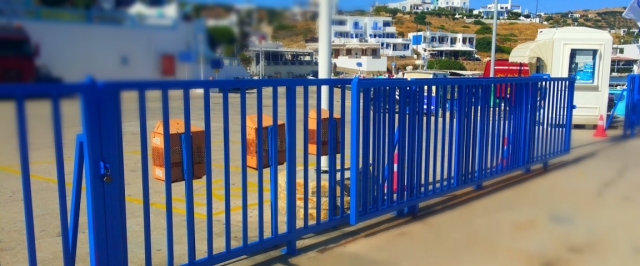Press here.
Places near Agios Georgios
Lipsi traveled through the centuries.
Its ancient name was Lepsia, as we know from inscriptions found on the island. As Lepsia also mentioned by Pliny.
The Lepsia or Lipsi occupied from the Final Neolithic / Early Bronze Age (4th-3rd millennium BC) as shown in pottery Castle positions, Agios Nikolaos and Liendou. Residents of this period were Carians who came from Asia Minor coasts. Followed by the Dorians (around circa 1200 BC and then the Ionians from Miletus in Asia Minor..
The geographical position of the island determined the historical route, linking it with Miletus. The political relationship of Lipsi with Miletus during the Hellenistic era, seems to resolutions of the island and referred to “Milesioi Lepsia dwell in.”
The most important monument of Lipsi is the Castle, on the hill that rises close to the land of Lipsi southeast Tarsanas. Here was the ancient Acropolis which preserved ancient relics with the built enclosure bastion gate and teeth.
On the southern slope of the hill outside the city walls, traces of terraces and abundant pottery suggest that there had developed the ancient settlement. The solemn holy Lipsi and place award of the resolutions was the sanctuary of Apollo Lepsieos, the location of which is located in the area where the small church of St. Nicholas.
The whole area of Agios Nikolaos as Panagia in Kouselio, is full of prehistoric pottery fragments up to the Early Christian period, architectural and buildings among which a Tetraconch of late antiquity. Corner Cape by crowning the altar “Milesian” type decoration ofthalmoton spirals and rosettes, from good working white marble, found in Agios Nikolaos and dates back to the mid-5th century example A similar marble cape kept in old bank of the Monastery of Patmos.
In ancient Lepsia, apart from the official worship of Apollo Leipsieos, there was a cult of Dionysus and Apollo Didyma as Venus. The myth that connects the Goddess with the Orion is still alive. In altars with votive inscriptions from the ancient Acropolis, listed Zeus Natal and Artemis Sotira.
During the Archaic period (7th-6th century BC) the island notes intellectual, artistic and cultural rise. The ancient Leipzig involved in agriculture, fisheries, animal husbandry, crafts and the arts. Bloom continued in the Classical period (5th-4th cent. BC). During the Hellenistic and Roman periods (3rd century example-3rd century AD) Lipsi although under Roman rule live in peace and grow as the water is no longer free from pirates and the circulation of ideas and goods flow seamlessly.
Life Lipsi never stopped. Continued strong and in later years when the position of the ancient temples were raised Christian.
During the Byzantine period (7os- 14th cent. AD) Lipsi part of the Theme of Kivyraioton (together with Kos, Tilos, Nisyros, Patmos, Kalymnos and Leros).
During the national uprising of 1821 the Leipsiotes participate actively. Here hosted the exiled Patriarch Theophilus of Alexandria Papakostas as “friendly” and admirals Miaoulis Andreas and George Sachtouris who took part in the historic battle of Elder (1824). During the Italian rule (1912-1943) the Dedocanese between them and Leipsoi- are named “Aegean Islands”. The Italians install small garrison and renamed “Lisso”. Released along with the rest of the Dodecanese whose formal and ceremonial reintegration with Greece will be held on March 7, 1948. A few days later, will take first General Governor of the Dodecanese, the fighter of the Dodecanese liberation struggle, ex Kasou doctor, Nicholas black.
To mention a local tradition according to which the founder of the country of Lipsi was the old-Lios, a Cretan who settled with his family in a cave above the beach Liendou and later built his house on the point where today the Church Museum.
Location
Lipsi or Lipso is cluster of 30 islands (24 islands and 6 rocks) in the south-eastern Aegean. It is 173.2 nm from Piraeus and has 790 inhabitants (2011). The main island, the main island from which comes the name of this cluster is located between Patmos (10.2 nm east) and Leros (8 miles north) and a little east of the imaginary line that the It connects to the north Dodecanese.
In the group of these small islands total area of 17 350 km² including islands: Arefousa, Manolis Islands, Grand Aspronisi, Long Aspronisi, Small Aspronisi, Quilt, Kouloura A Kouloura D South Aspronisi A South Aspronisi D Kalapodi Large, Small last, Lyra, cross, Pilavi, Psomou, Kaparonisi, Plate, Makronisi, Frank, Woodworm.
The surface of the main island Lipsi is 15.8 km². to spread coast 36 km. The land consists of low hills (maximum height is the Boats with 277 m., followed by the plate with 200 m. height in the NW part of it) and small valleys. There are also coves (Fontana, Muscat, shipyard, beaches (Liendou, Platis Gialos, Katsadia, Tourkomnima, Chochlakoura) and rocky headlands (Gato, Monodendri, Glarokavos).
Points Of Interest
The parish church in Chora Lipsi. Saint John the Theologian with two steeples “see” the natural harbor. The courtyard offers generous views. With marble floors, beautiful carved iconostasis, chandeliers, old holy utensils, beautiful paintings and metal altar bearing box raised and decorated with depictions of the life of Christ in Russian style.
Ecclesiastical, historical and folklore museum, called and “Nikiforeio”. Located next to the parish church of St. John the Theologian. Created by Panosiologiotato Nikiforos Koumoundouros. With care gathered from the countryside and chapels of great antiques include marble kionikrana (4th c. BC), grave findings such lamps, dakrychooi other pottery, marble slabs with ancient writing, clay pitchers, wood and silver crosses (17th century), tabernacles, ierokalymata, candlesticks (Russian construction 1800), images of the 16th century. Holy Gospels, old books, local costumes, old utensils and ancient amphorae synellexan fishermen of the island.
Agios Nektarios in Patela, cruciform with three domes. Here Keep carved bone reliquary of the saint and the fabric of the garments.
The archaeological site at “Castle” just outside the town of Lipsi. The findings indicate the existence of an ancient prehistoric city
The island has a large port divided into three zones:
tourist, for accommodating ships of any capacity
fishing boats and yachts (organized marina)
commercial cargo ships and for supplying water and fuel.





